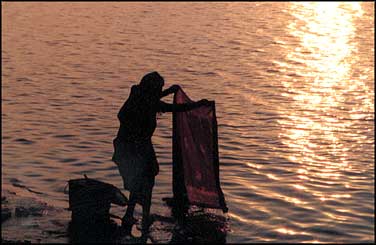|
 Known
as Pataligama to the Buddha, as Pataliputra to King Asoka
who made it capital of his vast empire, and in its most
recent reincarnation as Patna, this city is now the capital
of Bihar. It is a dusty nondescript city but of some interest
to the Buddhist pilgrim. The Buddha passed through here
several times including during his last journey to Kusinara
when he gave a talk "that went far into the night". Known
as Pataligama to the Buddha, as Pataliputra to King Asoka
who made it capital of his vast empire, and in its most
recent reincarnation as Patna, this city is now the capital
of Bihar. It is a dusty nondescript city but of some interest
to the Buddhist pilgrim. The Buddha passed through here
several times including during his last journey to Kusinara
when he gave a talk "that went far into the night".
The
Patna Museum has an outstanding collection of Buddhist art
mostly from the Pala period (8th to 12th centuries). My
favourites are the two exceptionally beautiful statues of
Avalokitesvara and Maitreya in the main gallery. With their
heads tilted pensively to one side and their gentle smiles
these statues perfectly express the ideal that the two bodhisattvas
embody; active and involved compassion. Most of the bronzes
from Kurkihar are in an upstairs gallery and there is a
large but now rather moth-eaten collection of Tibetan thankas
donated by the famous Indian monk Rahula Sankrityayana.
The museum is on Buddha Marg and is open from 10:30 am to
4:30 pm and closed on Monday. At Kumrahar there the remains
of King Asoka's palace, or at least of a Mauryian period
palace.
Other
than a single polished pillar there is not much to see.
Kumrahar is open from 9 am to 5:30 pm and closed o n
Monday. You'll find it on Old Bypass Road not far from the
approach to Mahatma Gandhi Bridge. If you have to stay in
Patna there are several reasonable hotels on and around
Fraser Road, not far from the museum. It is possible to
make three side trips using Patna as a base, one to Champanagar
and Vikramasila, another to Don and a third to Hajipur.
The first two of these places involve a lot of travelling
and will be of interest only to the real enthusiast. n
Monday. You'll find it on Old Bypass Road not far from the
approach to Mahatma Gandhi Bridge. If you have to stay in
Patna there are several reasonable hotels on and around
Fraser Road, not far from the museum. It is possible to
make three side trips using Patna as a base, one to Champanagar
and Vikramasila, another to Don and a third to Hajipur.
The first two of these places involve a lot of travelling
and will be of interest only to the real enthusiast.
|